Our last day in Savute – we have another long day of driving ahead of us (actually, for us it is just a long day of riding and taking pictures – Stanley and Bata have to do all the driving) before we arrive along the Chobe River at our last camping stop of the trip – this part of the Chobe National Park is called the Chobe Riverfront. However, as on previous occasions, we spend the first few hours of the day exploring the area that we are leaving, just in case there are things to see there.
And we are not disappointed. We quickly spot a Secretary Bird perched on a tree – we had not seen that before.
It is the first time that I noticed the ‘flash’ of feathers around its head which it seems to control for effect.
We also run into another large group of zebras
A little further we noticed two cars stopped at the same place – this is usually a good sign. Just as we pulled up, we noticed a
leopard walking in the tall grass.
It then went into a bush and I thought it was all over. However, if two bounces, just as I was taking its picture, it ran up
the bush, scaring some birds that were relaxing on the top branches.
It stayed at the top as if it was on the lookout for food and so we kept watching, wondering what could happen next.
… and then we discovered what it was really after – rest! Somehow, this does not look like a comfortable position – at least for me this would not be comfortable, but he seemed perfectly contented…
Not far, an Eagle is surveying the landscape
There are traces of human habitation in the rocky hills around the Savute area. In one place, there are rock paintings that
are probably 100’s of years old. We could not get close but you can see an elephant and other animals represented here.
Before we left Savute, we ran into another Leopard, this time drinking in a local water hole – two good looks at leopards in less than one hour – amazing…
We started to drive away from Savute and drove along the local airport (another long grass strip). There we ran into a couple of
ostriches – one of them showed me all the different positions that her neck can take
We also saw a huge elephant – we made our mid-morning break here and therefore stayed close to the cars while he was passing by.

We drove north from Savute towards the Chobe River, after which the Chobe National Park is named. We are still on small sandy tracks, but at times, it appears that we are on a multi-lane highway … this is just an area where the road has degraded in places and therefore drivers find alternate routes to climb the steep hill in fine sand – four-wheel drive absolutely necessary.

Our first glimpse of the Chobe River – it is much, much bigger than in past years because the rains in Angola have been very heavy over the past 6 months. The grassy area in the front of the picture is not normally flooded. The Chobe River runs into the Zambesi River about 50 km from this point and the Zambesi is a much bigger river. It is not unusual for the Chobe to run “backwards” when the Zambesi floods first. This year, they are both really high and therefore the Chobe is much wider than in previous years.

We have just spent 13 days “in the bush” with no electricity, no telephone, no radio, no Internet – nothing! The best roads we
have driven on have been hard packed dirt but all of a sudden we find ourselves on brand new, perfectly smooth tarmac. It is quite surprising and I am not sure I can handle to sudden return to ‘civilization’. We are certainly not dressed for it. You can tell that the road is very new as they are still working on it …
As we cross the Chobe National Park along this perfect road, we see these antelopes in the distance – these are Sables and very unusual – there are the only ones we saw, even if briefly and from a great distance.

We also run into a few Cape Buffaloes

But they seem to go on their way without noticing us.

Back inside the park, and once again on very poor dirt and sandy roads (I believe that they keep them in poor conditions to force people to drive slowly) we run into a group of Marabou Storks – one of them coming for a perfect landing.

On the ground, they do not look as majestic, just big ugly birds – sorry if I hurt any ones feelings …

We also saw a group of elephants coming to the water hole with a very young baby – this is about as small as we have seen in the whole trip
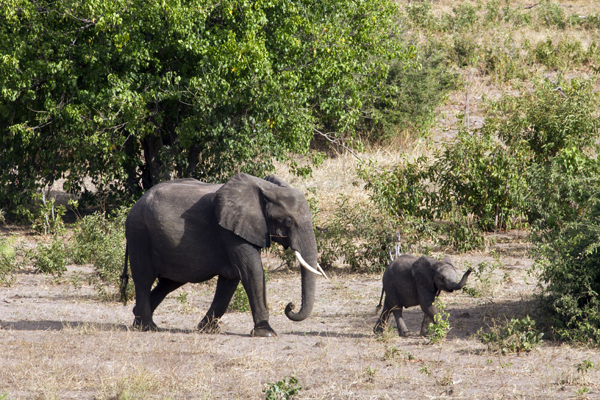
There is a large group of Impalas – al females – huddling under a tree

At the river’s edge, we run into a crocodile, the first we have seen.

A large elephant is hiding in the bushes – it is not easy for an elephant to hide successfully – it needs a really large bush…

A few Banded Mongooses relaxing in the shade (or do you say Mongeese? What is the plural of Mongoose?)

Baby baboon piggy back on mommy’s colorful rear

There is even time for a little toilette – I am always surprised with baboon how ‘human’ their expressions can be – in this case, I could easily put a balloon on the baboon that says: “What are you looking at?”
While daddy is hanging around, like he was riding a bus, baby baboon is playing with a leaf in the middle of the road.
DUNG 101 – how to attract the right mate with the correct dung ball. First one: FAIL! Shape: “Not Round”; Use: Impossible to move.
Second one: PASS, if he manages to get it across the street without losing it down the slope …
As we get word that out next camp is ready we can go back to our ‘home away from home’ and relax for the evening before dinner.
The following day, we spent the morning exploring the Chobe Riverfront. We saw another new type of antelope which we had not seen before: the Waterbuck – very thick coat and ian interesting ‘target’ on the back side.
And more spectacular Kudus
But then we ran into Cape Buffaloes which seemed to be paying a lot of attention to us – this is not usually good with these animals as they can be very aggressive.
However, they had something of their own to worry about. As we were watching the buffaloes ‘playing’ with each other and seemingly eating without concern, another tour guide told us that there was a lion nearby, actually a huge male lion that was resting in one of the bushes.
We were surprised to hear that, especially after we saw one of the buffaloes pass right in front of the bush where the lion was supposed to be hiding.
We kept looking and still could not see anything. Finally, we saw a little movement and noticed that indeed there was a
“nose” hardly visible amongst the branches. Not sure if you can spot it in this picture …
I have magnified the “critical” part in this one to make it easier. We looked for at least 10 minutes before we finally saw the lion – without the movement, we probably could not have seen it. If you look very carefully in the photo above, you can also see a leg of the lion on the right …
We saw more Warthogs with their peculiar style of eating
This one had particularly good looking fangs
We saw a pair of Impalas emerging from behind the trees.
After they became totally visible, we noticed that one had a rider on its back
In the river, there is a large pod of hippos – we are going for a boat ride on the river this afternoon and hoping that we will see a lot of different animals at that time.
But before the boat ride, we spend a short while in the town at the border between Zambia, Namibia, Zimbabwe and Botswana – the four countries meet where the Chobe River flows into the Zambesi into a pseudo “Four Corners” – the rivers are a sort of no-man’s land so that you can go from any country to any other, even diagonally.
The best flowers Kasane are on the side of the Police Station.
The local grocery store believes in being ready – I wonder how many years ago they painted this sign – I like the white Santa Claus with “Thumbs-up” even in April!
Signs do not come with “spell check”
In a construction site, employees we practicing their line dancing – not sure if they have a big event coming up.
We finally got on the boat around 3PM and crossed the Chobe River into the Namibian side. This local bar had to close as the
river has completely flooded it. It used to be popular with the local lads from Kasane before the water rose.
In the distance is the Namibian side of the river. It is now so big that there are several channels and these create an
island in the middle. There have been disputes between Botswana and Namibia as to who ‘owns’ the island; not sure why it worth fighting over a grassy marsh, but it became important enough to go to the United Nations for arbitration.
The island was finally ‘given’ to Botswana who installed a huge flag in the middle of it to let everybody know that this is theirs …
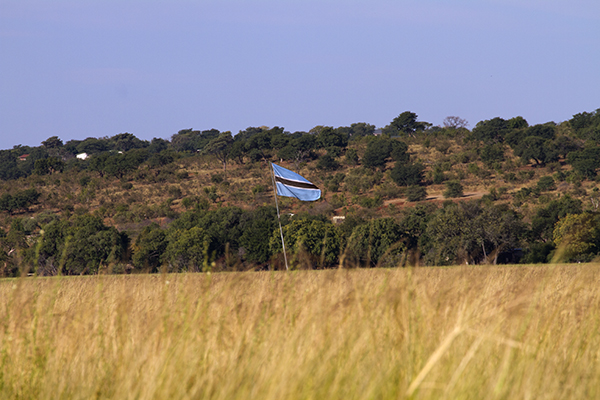
This is where I finally understood the difference between a Cormorant and a Darter. The Cormorant, on the left, grabs his prey and swallows it right away – it has a short curvy beak. The Darter, on the right, spears its fish with its long and straight beak. Both have to dry their wings after hunting because they do not have the same water repelling features of ducks and geese.
The Darter seemed to be posing for me
On the shore, we saw a large Monitor Lizard – this one is about 2 meters long, including the tail
A little further, there is a crocodile resting – it is too late for it to be sunning himself to get warm, so we guessed that he recently ate and was ‘digesting’…
We spent quite some time looking at it, and after a while, he seemed to get aggravated by our attention. However, our guide indicated that this is not a sign of anger, but rather a way for the crocodile to adjust his body temperature.
The local hippos turned their back on us, and seemed mostly bored …
But some did show interest and looked at us looking at them.
A little further, there were elephants taking a bath and really enjoying it. It seemed to be the time for elephant baths as we saw several groups all along the shore.
A pair of baboons drinking carefully – you never know what can be lurking in the water just off-shore.
Mother watching carefully as her brood is drinking
And dad is staying in the shade, looking very ‘cool’ with again a very ‘human-like’ attitude.
The Impalas are also very careful when they drink, staying as far away from the water as they possibly can.
Elephants do not need to be careful. This one is enjoying a mud bath
They typically have a mud bath after they wash in the river – the mud prevents all kinds of pests from attacking their skin.
We felt the earth tremble … as a herd of elephants were rapidly descending towards the shore – they were nearly running towards the water as if they had not had anything to drink in months …
We almost felt the water level dropping as they all started to drink at the same time.
So many large animals at the same place can lead to conflicts. These two males could not be fighting over the water – there is plenty for all, but they could be interested in the same female … one of them seems to be very excited about something.
The Snake Eagle is not impressed – this is a juvenile of the species…
Hippo munching on reeds surrounded by water lilies.
The town of Kasane viewed from the water – this is the fourth largest city in Botswana, strategically located at the crossing point between four countries and yet it is just a few streets and a couple of thousand inhabitants.
We had to get back to solid ground and drive back for our last night in camp. On the way we ran into more Marabou Storks – one of them had a large pouch on its neck, in order to impress the ladies…
We saw a large group of baboons. There was a very young baby playing in the dirt and eventually finding a leaf which was a lot more fun.
Baboon Expressions: (1) Surprise; (2) Boredom; (3) Interest and (4) Fascination!
A little further, we saw a few cars stopped together and once again figured that something special was happening. It was indeed – I took 85 photos in 15 minutes, but will not show them all to you!
We were in the presence of a large group of lions. We first saw one of the older females.
Who was soon joined by two cubs …
As I said – 85 photos in 15 minutes. This takes drive and dedication, as well as a lot of concentration. Here is half of our group, me included, snapping photos and totally mesmerized by the spectacle. Sue took this picture from the other car…
The two cubs soon became four … and this was getting better and better.
Obviously a very happy family enjoying a little quality time together.
Suddenly, the atmosphere changed … several of the adults started to come closer to us.
One even threatened us with a roar … we discovered that one of the juvenile was actually on the other side of the road a separated from the rest of the pride by all the vehicles that had accumulated (more than ten trucks were there by this time).
A young male, with its mane just developing, came very close to us. He must have been in a fight recently, or hurt while hunting as he had a wound on his lower back.
But then the older females decided to escort the younger cubs across the road – the kids did not realize what was happening and were playing like kids usually do.
Soon the crisis is over and the whole pride was back together – relief is almost visible on the older lionesses
This is a very close family – probably mother and daughter showing affection for each other.
This was our last night in the camp and therefore the last night with the crew who had helped us for the whole trip. The next morning, we said our goodbyes and took pictures of the whole crew together – I did not have my camera ready and so had to depend on this photo donated by Sue.
We also took pictures of the ‘tourists’ (Happy Campers?) all together.
On the way out of camp, we ran into a road block, at the same place where we had seen the lions the day before … what could it be???
The pride of lions is back, but this time the male is with them – he is looking, with pride, from a distance.
The family is relaxing under a tree
But it is time for us to leave Botswana and go across the Zambesi into Zambia. At the hotel in Kasane where we are waiting for the bus to take us to the border crossing, there is a wedding getting ready. The flower girls are already there, all in pink
And the guests of honor arrive, in traditional costumes.
I am not sure, however, that an Arsenal skirt can be considered a traditional dress …
We are off to Zambia and to Victoria Falls, which I will cover in my next post – that will be the last for this trip.
(3823 Page Views)

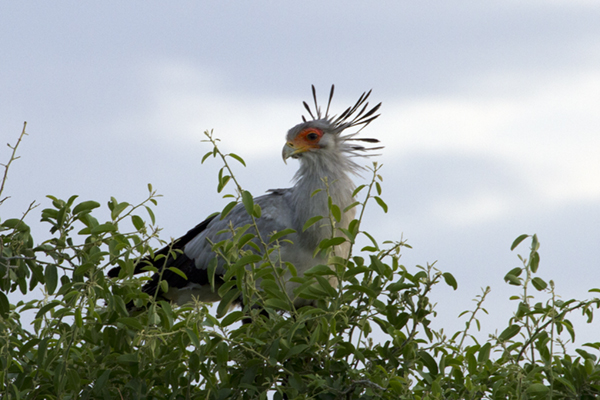









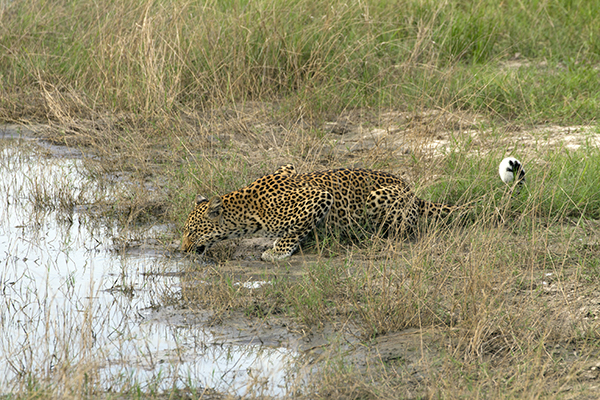









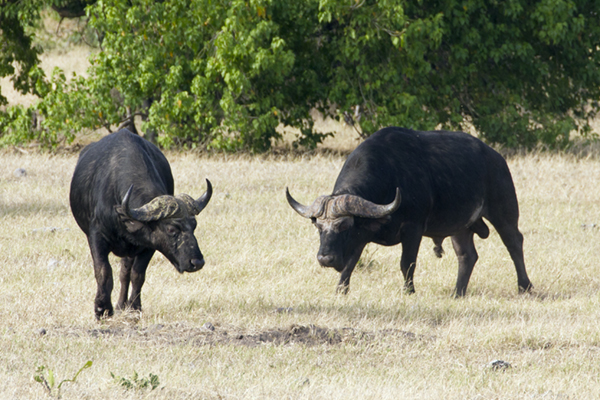






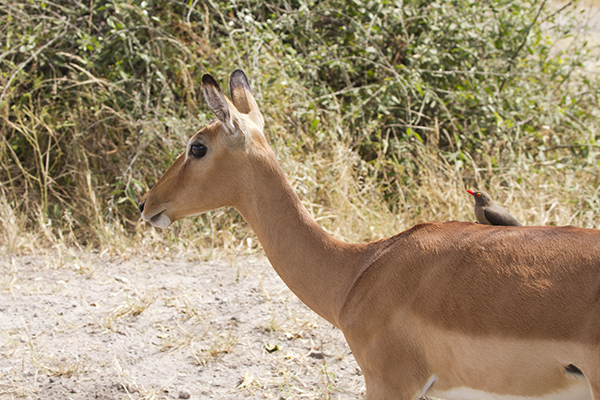




















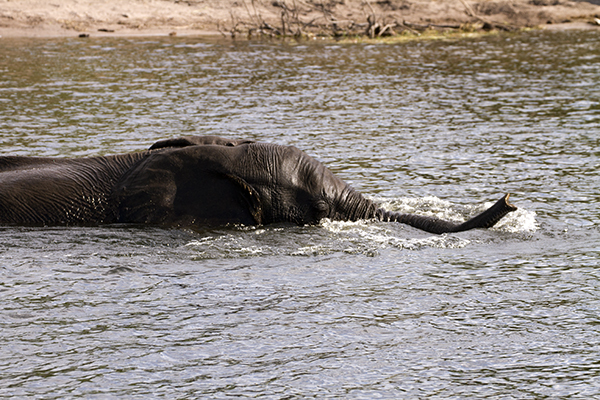


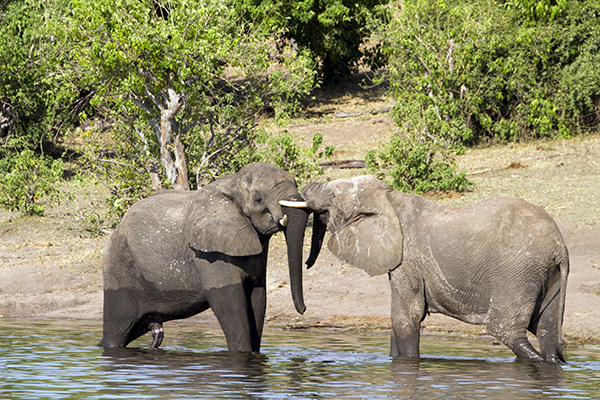


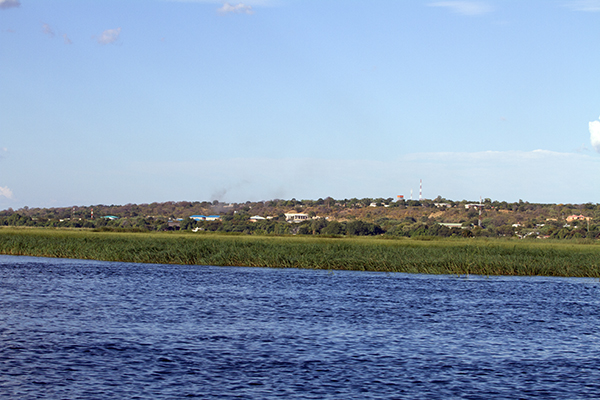





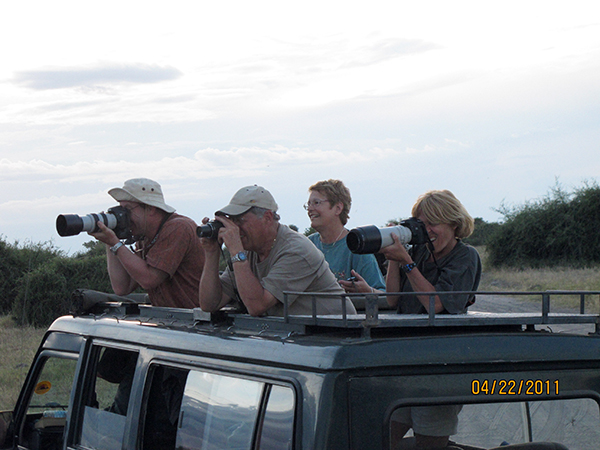











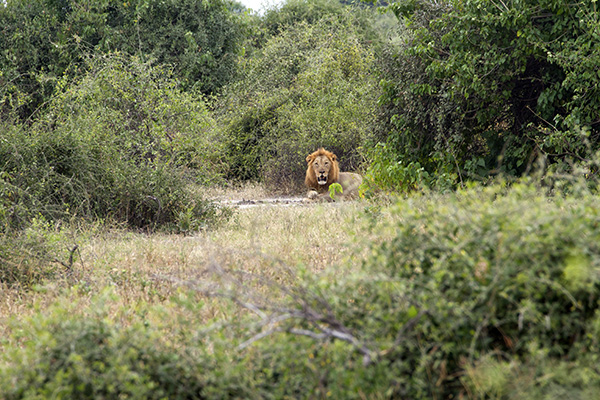





Awesome photos. 85 in 15 mins? That has to be a record. Definitely worth risking RSI for. 🙂